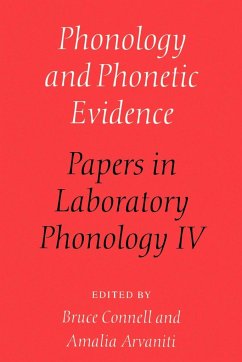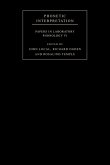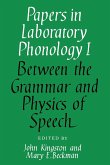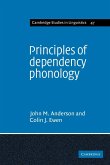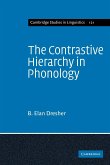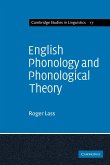Bruce Connell / Amalia Arvaniti (eds.)Papers in Laboratory Phonology IV
Phonology and Phonetic Evidence
Papers in Laboratory Phonology IV
Herausgeber: Connell, Bruce; Arvaniti, Amalia
Bruce Connell / Amalia Arvaniti (eds.)Papers in Laboratory Phonology IV
Phonology and Phonetic Evidence
Papers in Laboratory Phonology IV
Herausgeber: Connell, Bruce; Arvaniti, Amalia
- Broschiertes Buch
- Merkliste
- Auf die Merkliste
- Bewerten Bewerten
- Teilen
- Produkt teilen
- Produkterinnerung
- Produkterinnerung
This work presents an integrated phonetics-phonology approach in what has now become an established field, laboratory phonology.
Andere Kunden interessierten sich auch für
![Phonetic Interpretation Phonetic Interpretation]() Phonetic Interpretation51,99 €
Phonetic Interpretation51,99 €![Phonology and Language Use Phonology and Language Use]() Joan BybeePhonology and Language Use64,99 €
Joan BybeePhonology and Language Use64,99 €![Papers in Phonology Papers in Phonology]() John Kingston / E. Beckman (eds.)Papers in Phonology84,99 €
John Kingston / E. Beckman (eds.)Papers in Phonology84,99 €![Metrical Phonology and Phonological Structure Metrical Phonology and Phonological Structure]() Heinz J. GiegerichMetrical Phonology and Phonological Structure55,99 €
Heinz J. GiegerichMetrical Phonology and Phonological Structure55,99 €![Principles of Dependency Phonology Principles of Dependency Phonology]() John M. AndersonPrinciples of Dependency Phonology56,99 €
John M. AndersonPrinciples of Dependency Phonology56,99 €![The Contrastive Hierarchy in Phonology The Contrastive Hierarchy in Phonology]() B. Elan DresherThe Contrastive Hierarchy in Phonology57,99 €
B. Elan DresherThe Contrastive Hierarchy in Phonology57,99 €![English Phonology and Phonological Theory English Phonology and Phonological Theory]() Roger LassEnglish Phonology and Phonological Theory47,99 €
Roger LassEnglish Phonology and Phonological Theory47,99 €-
-
-
This work presents an integrated phonetics-phonology approach in what has now become an established field, laboratory phonology.
Hinweis: Dieser Artikel kann nur an eine deutsche Lieferadresse ausgeliefert werden.
Hinweis: Dieser Artikel kann nur an eine deutsche Lieferadresse ausgeliefert werden.
Produktdetails
- Produktdetails
- Verlag: Cambridge University Press
- Seitenzahl: 420
- Erscheinungstermin: 19. Juli 1995
- Englisch
- Abmessung: 229mm x 152mm x 25mm
- Gewicht: 679g
- ISBN-13: 9780521483889
- ISBN-10: 0521483883
- Artikelnr.: 21212601
- Herstellerkennzeichnung
- Libri GmbH
- Europaallee 1
- 36244 Bad Hersfeld
- gpsr@libri.de
- Verlag: Cambridge University Press
- Seitenzahl: 420
- Erscheinungstermin: 19. Juli 1995
- Englisch
- Abmessung: 229mm x 152mm x 25mm
- Gewicht: 679g
- ISBN-13: 9780521483889
- ISBN-10: 0521483883
- Artikelnr.: 21212601
- Herstellerkennzeichnung
- Libri GmbH
- Europaallee 1
- 36244 Bad Hersfeld
- gpsr@libri.de
1. Introduction Bruce Connell and Amalia Arvanti; Part I. Features and
Perception: 2. Intermediate properties in the perception of distinctive
feature values John Kingston and Randy L. Diehl; 3. A double weak view of
trading relations: comments on Kingston and Diehl Terrance M. Nearey; 4.
Speech perception and lexical representations: the role of vowel
nasalization in Hindi and English John J. Ohala and Manjari Ohala; 5.
Processing versus representation: comments on Ohala and Ohala James M.
McQueen; 6. On the status of redundant features: the case of backing and
rounding Kenneth De Jong; 7. The perceptual basis of some sound patterns
John J. Ohala; Part II. Prosody: 8. Stress shift: do speakers do it or do
listeners hear it? Esther Grabe and Paul Warren; 9. The phonology and
phonetics of the rhythm rule Irene Vogel, Timothy Bunnell, and Steven
Hoskins; 10. The importance of phonological transcription in empirical
approaches to 'stress shift' versus 'early accent': comments on Grabe and
Warren, and Vogel, Bunnell and Hoskins Stefanie Shattuck-Hufnagel; 11.
Perceptual evidence for the mora in Japanese Haruo Kubozono; 12. On
blending and the mora: comments on Kubozono Mary E. Beckman; 13. Toward a
theory of phonological and phonetic timing: evidence from Bantu Kathleen
Hubbard; 14. On phonetic evidence for the phonological mora: comments on
Hubbard Bernard Tranel; Part III. Articulatory Organization: 15. Prosodic
patterns in the coordination of vowel and consonant gestures Caroline L.
Smith; 16. 'Where' is timing?: comments on Smith Richard Ogden; 17.
Asymmetrical prosodic effects on the laryngeal gesture in Korean Sun-Ah
Jun; 18. On a gestural account of lenis stop voicing in Korean: comments on
Jun Gerard J. Docherty; 19. A production and perceptual account of
palatalization Daniel Recasens, Jordi Fontdevilla, and Maria Dolors
Palleres; 20. An acoustic and electropalatographic study of lexical and
postlexical palatalization in American English Elizabeth C. Zsiga; 21. What
do we do when phonology is powerful enough to imitate phonetics: comments
on Zsiga James M. Scobbie; 22. The influence of syntactic structure on [s]
to [ ] assimilation Tara Holst and Francis Nolan; 23. Assimilation as
gestural overlap: comments on Holst and Nolan Catherine P. Browman; 24.
Orals, gutturals and the jaw Sook-Hang Lee; 25. The role of the jaw -
active or passive?: comments on Lee Francis Nolan; 26. The phonetics and
phonology of glottalized consonants in Lendu Didier Demolin; 27. Lendu
consonants and the role of overlapping gestures in sound change: comments
on Demolin Louis Goldstein; Indexes.
Perception: 2. Intermediate properties in the perception of distinctive
feature values John Kingston and Randy L. Diehl; 3. A double weak view of
trading relations: comments on Kingston and Diehl Terrance M. Nearey; 4.
Speech perception and lexical representations: the role of vowel
nasalization in Hindi and English John J. Ohala and Manjari Ohala; 5.
Processing versus representation: comments on Ohala and Ohala James M.
McQueen; 6. On the status of redundant features: the case of backing and
rounding Kenneth De Jong; 7. The perceptual basis of some sound patterns
John J. Ohala; Part II. Prosody: 8. Stress shift: do speakers do it or do
listeners hear it? Esther Grabe and Paul Warren; 9. The phonology and
phonetics of the rhythm rule Irene Vogel, Timothy Bunnell, and Steven
Hoskins; 10. The importance of phonological transcription in empirical
approaches to 'stress shift' versus 'early accent': comments on Grabe and
Warren, and Vogel, Bunnell and Hoskins Stefanie Shattuck-Hufnagel; 11.
Perceptual evidence for the mora in Japanese Haruo Kubozono; 12. On
blending and the mora: comments on Kubozono Mary E. Beckman; 13. Toward a
theory of phonological and phonetic timing: evidence from Bantu Kathleen
Hubbard; 14. On phonetic evidence for the phonological mora: comments on
Hubbard Bernard Tranel; Part III. Articulatory Organization: 15. Prosodic
patterns in the coordination of vowel and consonant gestures Caroline L.
Smith; 16. 'Where' is timing?: comments on Smith Richard Ogden; 17.
Asymmetrical prosodic effects on the laryngeal gesture in Korean Sun-Ah
Jun; 18. On a gestural account of lenis stop voicing in Korean: comments on
Jun Gerard J. Docherty; 19. A production and perceptual account of
palatalization Daniel Recasens, Jordi Fontdevilla, and Maria Dolors
Palleres; 20. An acoustic and electropalatographic study of lexical and
postlexical palatalization in American English Elizabeth C. Zsiga; 21. What
do we do when phonology is powerful enough to imitate phonetics: comments
on Zsiga James M. Scobbie; 22. The influence of syntactic structure on [s]
to [ ] assimilation Tara Holst and Francis Nolan; 23. Assimilation as
gestural overlap: comments on Holst and Nolan Catherine P. Browman; 24.
Orals, gutturals and the jaw Sook-Hang Lee; 25. The role of the jaw -
active or passive?: comments on Lee Francis Nolan; 26. The phonetics and
phonology of glottalized consonants in Lendu Didier Demolin; 27. Lendu
consonants and the role of overlapping gestures in sound change: comments
on Demolin Louis Goldstein; Indexes.
1. Introduction Bruce Connell and Amalia Arvanti; Part I. Features and
Perception: 2. Intermediate properties in the perception of distinctive
feature values John Kingston and Randy L. Diehl; 3. A double weak view of
trading relations: comments on Kingston and Diehl Terrance M. Nearey; 4.
Speech perception and lexical representations: the role of vowel
nasalization in Hindi and English John J. Ohala and Manjari Ohala; 5.
Processing versus representation: comments on Ohala and Ohala James M.
McQueen; 6. On the status of redundant features: the case of backing and
rounding Kenneth De Jong; 7. The perceptual basis of some sound patterns
John J. Ohala; Part II. Prosody: 8. Stress shift: do speakers do it or do
listeners hear it? Esther Grabe and Paul Warren; 9. The phonology and
phonetics of the rhythm rule Irene Vogel, Timothy Bunnell, and Steven
Hoskins; 10. The importance of phonological transcription in empirical
approaches to 'stress shift' versus 'early accent': comments on Grabe and
Warren, and Vogel, Bunnell and Hoskins Stefanie Shattuck-Hufnagel; 11.
Perceptual evidence for the mora in Japanese Haruo Kubozono; 12. On
blending and the mora: comments on Kubozono Mary E. Beckman; 13. Toward a
theory of phonological and phonetic timing: evidence from Bantu Kathleen
Hubbard; 14. On phonetic evidence for the phonological mora: comments on
Hubbard Bernard Tranel; Part III. Articulatory Organization: 15. Prosodic
patterns in the coordination of vowel and consonant gestures Caroline L.
Smith; 16. 'Where' is timing?: comments on Smith Richard Ogden; 17.
Asymmetrical prosodic effects on the laryngeal gesture in Korean Sun-Ah
Jun; 18. On a gestural account of lenis stop voicing in Korean: comments on
Jun Gerard J. Docherty; 19. A production and perceptual account of
palatalization Daniel Recasens, Jordi Fontdevilla, and Maria Dolors
Palleres; 20. An acoustic and electropalatographic study of lexical and
postlexical palatalization in American English Elizabeth C. Zsiga; 21. What
do we do when phonology is powerful enough to imitate phonetics: comments
on Zsiga James M. Scobbie; 22. The influence of syntactic structure on [s]
to [ ] assimilation Tara Holst and Francis Nolan; 23. Assimilation as
gestural overlap: comments on Holst and Nolan Catherine P. Browman; 24.
Orals, gutturals and the jaw Sook-Hang Lee; 25. The role of the jaw -
active or passive?: comments on Lee Francis Nolan; 26. The phonetics and
phonology of glottalized consonants in Lendu Didier Demolin; 27. Lendu
consonants and the role of overlapping gestures in sound change: comments
on Demolin Louis Goldstein; Indexes.
Perception: 2. Intermediate properties in the perception of distinctive
feature values John Kingston and Randy L. Diehl; 3. A double weak view of
trading relations: comments on Kingston and Diehl Terrance M. Nearey; 4.
Speech perception and lexical representations: the role of vowel
nasalization in Hindi and English John J. Ohala and Manjari Ohala; 5.
Processing versus representation: comments on Ohala and Ohala James M.
McQueen; 6. On the status of redundant features: the case of backing and
rounding Kenneth De Jong; 7. The perceptual basis of some sound patterns
John J. Ohala; Part II. Prosody: 8. Stress shift: do speakers do it or do
listeners hear it? Esther Grabe and Paul Warren; 9. The phonology and
phonetics of the rhythm rule Irene Vogel, Timothy Bunnell, and Steven
Hoskins; 10. The importance of phonological transcription in empirical
approaches to 'stress shift' versus 'early accent': comments on Grabe and
Warren, and Vogel, Bunnell and Hoskins Stefanie Shattuck-Hufnagel; 11.
Perceptual evidence for the mora in Japanese Haruo Kubozono; 12. On
blending and the mora: comments on Kubozono Mary E. Beckman; 13. Toward a
theory of phonological and phonetic timing: evidence from Bantu Kathleen
Hubbard; 14. On phonetic evidence for the phonological mora: comments on
Hubbard Bernard Tranel; Part III. Articulatory Organization: 15. Prosodic
patterns in the coordination of vowel and consonant gestures Caroline L.
Smith; 16. 'Where' is timing?: comments on Smith Richard Ogden; 17.
Asymmetrical prosodic effects on the laryngeal gesture in Korean Sun-Ah
Jun; 18. On a gestural account of lenis stop voicing in Korean: comments on
Jun Gerard J. Docherty; 19. A production and perceptual account of
palatalization Daniel Recasens, Jordi Fontdevilla, and Maria Dolors
Palleres; 20. An acoustic and electropalatographic study of lexical and
postlexical palatalization in American English Elizabeth C. Zsiga; 21. What
do we do when phonology is powerful enough to imitate phonetics: comments
on Zsiga James M. Scobbie; 22. The influence of syntactic structure on [s]
to [ ] assimilation Tara Holst and Francis Nolan; 23. Assimilation as
gestural overlap: comments on Holst and Nolan Catherine P. Browman; 24.
Orals, gutturals and the jaw Sook-Hang Lee; 25. The role of the jaw -
active or passive?: comments on Lee Francis Nolan; 26. The phonetics and
phonology of glottalized consonants in Lendu Didier Demolin; 27. Lendu
consonants and the role of overlapping gestures in sound change: comments
on Demolin Louis Goldstein; Indexes.

